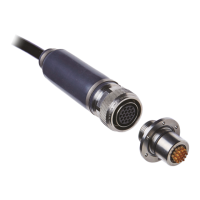Handling instructions
for GISMA connectors
HI – 2007 - 001
Document: replaces
MV 2000-020,
MV 2000-030 and
MV 2005 - 011
First issue: 15.07.2008
Rev.-Index: -Z-
From: 29.07.2020
Page 7 of 44
Stainless steel (1.4404/ 1.4571 comparable to 316L/316Ti) or titanium grade 5 stab plate con-
nectors must be connected to the CP (Cathodic Protection) system at all times. If the connector
is designed with a fixed flange and screw mounting, an additional CP connecting would not be
required. Super Duplex stainless steel connectors should be isolated from the CP system to
reduce the possibility of hydrogen embrittlement.
If the connectors are to be left unmated in seawater for any length of time, pressure watertight
protective caps must be used to protect the contacts. Over exposure will increase the risk of
corrosion damage or marine growth on the contact surfaces of the pin contacts. This could lead
to damage to the seals and insulation within the socket contacts.
The appropriate test connector must always be used to make electrical contact during testing.
UNDER NO CIRCUMSTANCES should a foreign object (such as a screwdriver, test probe or
crocodile clip) be used as a test connection as this could damage the seals and insulation. Such
actions will invalidate the warranty of the connector.
Attention: The customer is responsible for the safe operation of the connectors and cable
systems. All necessary protective measures must be taken.
Test connectors or free touchable connectors with metal shell must be connected to the
earth conductor.
The series 10 range of connectors can be supplied either singularly or as part of a harness
assembly. All series 10 connectors require the following acceptance tests during termination:
Mating test
Insulation Resistance test
High Voltage test
Continuity test
Cable terminations can be performed on-site or offshore by GISMA trained personnel where the
cable cannot easily be moved or transported. Each series 10 connector has been mated,
hydrostatically tested (applies to receptacles only) and electrically proven prior to despatch.
Termination of these connectors should only be undertaken by trained personnel.
7.1.2. Live Mate / Demate
The series 10 range of connectors are designed to be mated / de-mated with POWER OFF.
7.1.3. Protection of receptacle’s pin contacts
Under no circumstances the contacts should be exposed to seawater with power on. If this
situation does occur the contact surfaces of the contacts will very rapidly degrade by electrolytic
action. If these damaged pins are subsequently mated into a socket insert there is a very high
risk of damage to the insulation and seals within the plug.
7.1.4. Removal of Marine Growth and Calcareous Deposits
To remove calcite growth topside or subsea from GISMA connectors, a solution of 50% Citric Acid
is recommended. All seawater exposed elastomeric materials in GISMA connectors have been
fully tested against 50% Citric Acid and are compatible for duration of 1 hour. In addition, the
thermoplastic materials have good resistance to Citric Acid.

